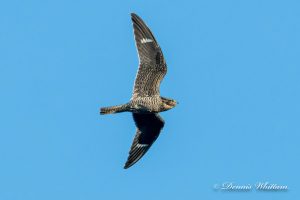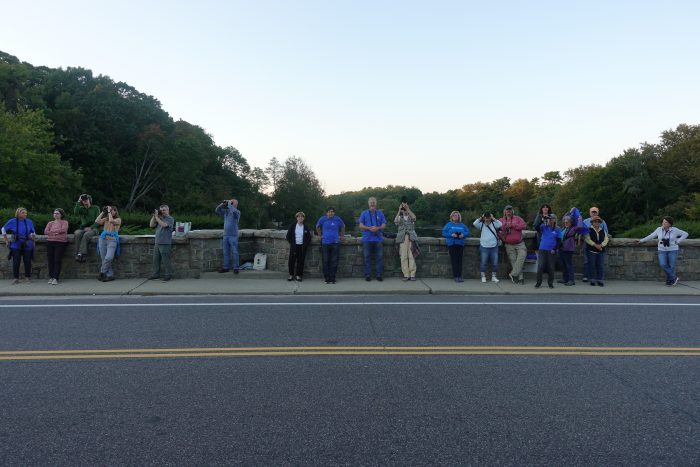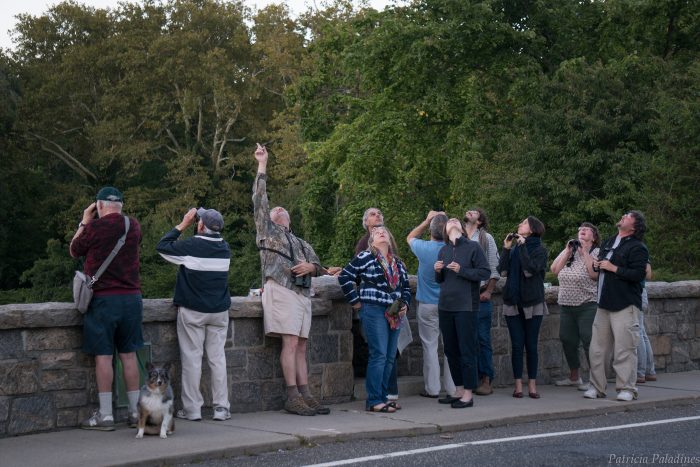On Aug. 27 at 5:30 p.m., the Four Harbors Audubon Society will begin its seventh “Common Nighthawk Watch” on the Stone Bridge located along the southern boundary of Frank Melville Memorial Park in Setauket. The watch will run through to Oct. 6.
The Common Nighthawk, a bird quite adept in flight, passes through Long Island on its southbound migration in the autumn after leaving their breeding grounds across northern North America and heading to the Amazon region and beyond in South America. The nighthawks passing over the Watch are very likely birds that nested in eastern Canada and New England.
The Audubon chapter began the Watch in 2017 in response to concerns about declining nighthawk numbers. Based on the last published NYS Breeding Bird Atlas, this species has experienced a 71% reduction in the number of birds that possibly or probably bred or were confirmed as breeders in New York State from 1985 to 2005. While continental figures paint a slightly better picture, the trend in nighthawk numbers is still a downward one.

“Anyone who witnesses the daily evening migration of Common Nighthawks at the Stone Bridge is hooked; the spectacle is no less than addicting. Yet the bigger picture is disheartening, as we know nighthawks are in steep decline, and the numbers we see are but a small percentage of their historic population levels,” notes Patrice Domeischel, a chapter board member and a co-founder of the Watch. “Hopefully in time our data collection will prove useful in determining ways to preserve this species.”
Why so many nighthawks appear over the Stone Bridge is not fully clear but two aspects appear to contribute: the geographic position of Setauket along Long Island’s north shore is ideal for intercepting southbound nighthawks as they reach Long Island after crossing the Sound and the presence of the pond that regularly produces an insect hatch that provides a cafeteria for the birds.
“Common Nighthawks are related to whip-poor-wills” said John Turner, Conservation co-chair of the chapter and a chapter board member, “but are distinctive with their bright white wing bars that flash as they dip and turn in pursuit of the aerial insects that form their diet.”
The reduction in the abundance of aerial insects due to spraying and habitat loss appears to be the main driver of reduced nighthawk numbers. “These birds serve as bellwethers for the quality of the environment and their decline should be a concern to us all,” Turner added.
The totals for the number of common nighthawks counted as they zip, bob, and weave erratically overhead for the past six years is as follows: 2,046 nighthawks in 2017, 2,018 nighthawks in 2018, 2,757 nighthawks in 2019, 2,245 nighthawks in 2020, 1,819 nighthawks in 2021, and 1,625 nighthawks in 2022. The single best day observers have had was on Sept. 8, 2017 when 573 nighthawks passed overhead. Last year the best day was the first— Aug. 27 — when 243 birds moved through.
Many other bird species are observed at the Watch including Bald Eagles and Ospreys, Double-crested Cormorants, Barn and Tree Swallows and Chimney Swifts, several duck species including the beautiful Wood Duck, Belted Kingfisher, wading birds such as Great Egrets, and many species of songbirds. Toward dusk, several species of bats often emerge to feed over the pond and if any planets are visible in the sky a birding scope is set up to look at them (the ring of Saturn can be seen with a high powered bird scope).
For more information, visit www.4has.org.






